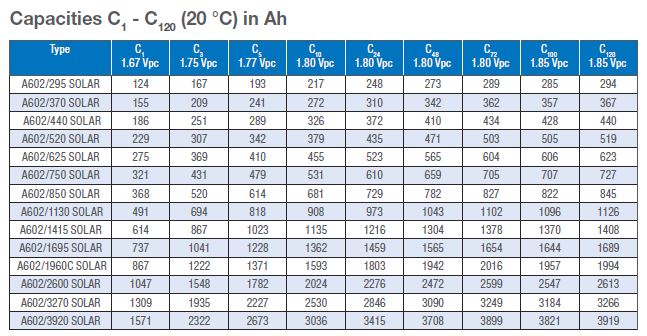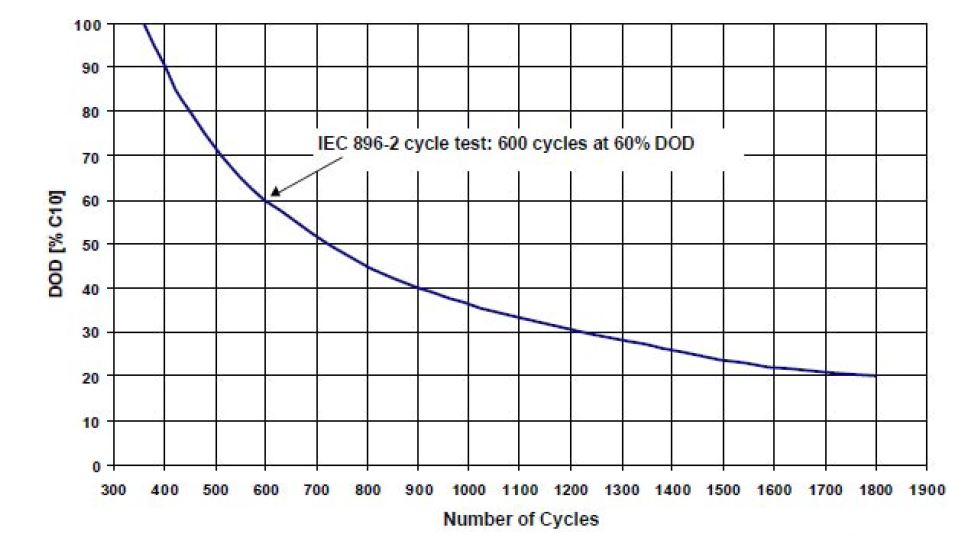Manufacturers have varying methods to specify battery performance. What may seem like unimportant details, can significantly change the perceived performance of a particular battery. This article is in reference to lead acid batteries, but the general principals can apply to other battery types as well. Here are some things you have to consider:
1) Ampere-Hours
The Ampere-Hour or Ah rating of a battery is how they specify the size or amount of energy stored in a battery. It is calculated by multiplying Amperes x Hours at a particular rate of discharge or C-Rate.
2) Watts
Some batteries are only specified in Watts per cell or per block for a specified time. Small batteries may be specified as Watts for 15 minutes down to 1.67 volts per cell at 25degC. This standard was created in the Uninterruptible Power Supply or UPS industry to specify the ratings for UPS batteries. A UPS inverter basically draws a constant watt load, or in other words; the current (amperes) increases as the battery voltage decreases. The more Watts a battery can provide over a short duration the better. This can be achieved by putting more plates and thinner plates inside the battery to reach higher performance. There is no straight forward conversion between Watts and Amperes, but it can be estimated by dividing Watts and the Average Discharge Voltage. The Average Discharge Voltage for a 12V block is around 11.5V or 1.92V for an individual cell.
3) C-Rate
C-rate refers to how fast a battery is discharged and is most commonly specified at 5, 8, 10, 20 or 100 hours. If a battery is rated 100Ah at the C20 rate, this means that it can discharge at 5 Amps for 20 hours. However, if the same battery is discharged at the C5 rate it may only provide 16.5 Amps for 5 hours, or in other words the C5 rate is 82.5Ah. The lower capacity at a faster discharge rate is the result of resistive and chemical losses. So you have to know how much current your application requires and size the battery appropriately based upon the rate of discharge. Just because one battery has a higher Ah rating than another battery, it may not actually have more capacity because of the specified C-Rate.

4) Temperature
Temperature affects the ability of a battery to supply current. Lower temperatures reduce capacity due to reduced chemical reaction. Battery performance is most commonly specified at 20, 25 and 27degC. The battery capacity difference between 20 and 27degC is about 8%. So a 100Ah/20degC rated battery could supply around 108Ah at 27degC, or conversely a 100Ah/27degC rated battery would be only able to supply around 92.6Ah at 20degC
5) End of Discharge Voltage or Volts per Cell
The End of Discharge Voltage or Volts per Cell is the minimum voltage which will still allow the connected loads to operate properly. In a UPS, this could be the point where the inverter has to shut down or in a switchgear system, this could be the point where the motor operators and solenoid coils can still operate. This must be considered in conjunction with C-Rate to properly size a battery. For example, in an application with high discharge current for a short time, the battery will reach a high end of discharge voltage of around 1.90V/cell very quickly. If the equipment will operate down to 1.67V/cell then you can better utilize the available battery capacity. Conversely, if you have a low current load for a long time, the average battery voltage will be quite high and you can effectively utilize full capacity out of the battery.
6) Cycle Life and Depth of Discharge
The Cycle Life is the amount of times a battery can be discharged and charged. One discharge and recharge represents one cycle. It can be specified in a number of ways depending upon the Depth of Discharge (DOD) and C-Rate. Depth of Discharge is the percentage of capacity that is discharged from the battery. Some of the most common methods are 2-hour BCI (effectively C2 rate or around 84% DOD), IEC896 (60% DOD), or possibly a graph based upon DOD. For example, a manufacturer might specify a cycle rating of 1200 cycles for a battery. You have to verify the DOD the 1200 cycles is rated at because that could be at 30% DOD. Conversely, a battery may have a rating of 800 cycles at 80% DOD, but that actually represents much higher performance than 1200 cycles at 30% DOD.

If you want to speak with a professional please call (905-681-8227), email info@advancedbattery.ca, or fill out our contact form on our website www.advancedbattery.ca.
If you have a topic you want us to cover please send your suggestions to info@advancedbattery.ca
